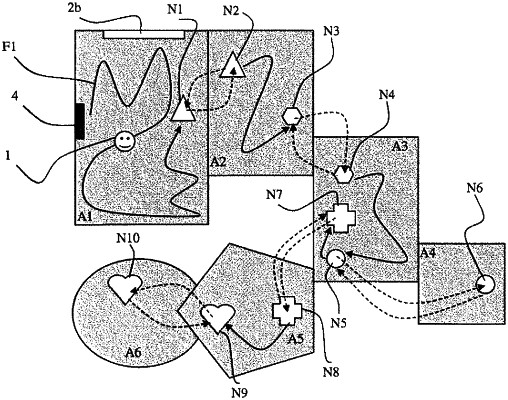| CPC G06F 16/9577 (2019.01) [G06F 16/954 (2019.01); G06T 19/003 (2013.01); H04L 63/101 (2013.01); H04W 4/029 (2018.02); G06F 3/04815 (2013.01)] | 13 Claims |

|
1. A method of navigation from or within the network address of a three-dimensional space of a three-dimensional network site comprising:
a network address (URL1-URL6),
at least one three-dimensional space (A1-A6: B1-B3);
at least one object (1) that is mobile and controllable in the space (A1-A6: B1 -B3);
at least one navigation object (N1-N26) placed at a position (P11b) of the navigation object, the navigation object being programmed to detect whether the mobile object (1) overlaps a detection zone (N112), and to generate a navigation action as a function of the navigation properties assigned to the navigation object (N11) when the mobile object (1) overlaps the detection zone (N112);
the three-dimensional network site being associated with an access table comprising at least the following items of information:
the descriptor of the access table so as to be able to be interpreted by the navigation software package, comprising the number of rows, the number of columns and the field separator(s) used;
an identifier (P11a) of the or of each three-dimensional space in the site;
an identifier of the or of each navigation object;
the position (P11b) of each navigation object: the navigation properties of each navigation object; and
an initial position (4, 6) of the mobile object when a user accesses the site, the method being performed with aid of a hardware interface, and comprising, for a forward navigation:
a) in a navigation software package suitable for the hardware interface:
a.1) opening the network address (URL1-URL6);
a.2) controlling the movement of the mobile object (1) in the or one of the three-dimensional spaces (A1-A6; B1-B3) from the initial position (4, 6);
a.3) selecting the navigation object (N1-N26) by positioning the mobile object (1) in an overlapping manner with respect to the navigation object (N1-N26);
a.4) starting a timeout of predefined duration, as soon as the mobile object (1) and the navigation object (N1-N26) or the detection zone (N112) overlap,
a.6) generating a navigation action as a function of the navigation properties assigned to the navigation object (N1-N26), only if the mobile object (1) and the navigation object (N1-N26) or the detection zone (N112) remain overlapped throughout the duration of the timeout;
wherein: step a.1) further comprises creation and storage in memory of a first history table (P1) of a last in-first out type, as well as an association of the first history table with:
previous position and next position selectable buttons of the network site for navigation between several 3D spaces having the same common network address: or
with page forward and page back selectable buttons of the navigation software package for navigation between several 3D spaces each having its own network address; and
step (a.6)comprises an insertion, as first entry (P11, P1a) in the first history table (P1), of an item of history information in respect of location of the mobile object in the previous spatial position;
wherein step a) is repeated n-2 times, n being an integer greater than or equal to 3, the first history table being created only at the first iteration and supplemented during the other iterations, each iteration of step a) corresponding to anew item of history information in respect of location of the mobile object in the previous spatial position being stored chronologically at each iteration in the first history table during navigation:
the method further comprising, for a backward navigation:
a step B) of backtracking consisting in reading the item of history information in respect of location of the mobile object in the previous spatial position of rank n-1 in the first history table, and in positioning the mobile object at its location in the spatial position of rank n-1, step B) being repeated k times, k being an integer lying between 1 and n-2, and
the method further comprising, for a bifurcation in navigation towards a new direction not yet stored in the first history table:
if k lies between 1 and n-3, after the iteration of rank k of step B), at least one step v) of navigating the mobile object in a new direction by selecting a navigation object not vet stored in the first history table, step v) comprising the following sub-steps:
v.1) creation and storage in memory of a second history table of “last in-first out” type, as well as an association of the second history table with a “page forward” and a “page back” selectable buttons of the network site or of the navigation software package;
v.2) controlling the movement of the mobile object in the or one of the three-dimensional spaces of the network site;
v.3) selecting the navigation object not yet stored in the first history table by positioning the mobile object in an overlapping manner with respect to the navigation object;
v.6) generating a navigation action as a function of the navigation properties assigned to the navigation object, and inserting:
as first entry in the second history table, a reference to the first history table;
as second entry in the second history table, an item of history information in respect of location of the mobile object in the previous spatial position as last entry in the first history table, a reference to the second history table;
the method further comprising repeating steps y) for each new bifurcation, step y1) comprising the creation of an additional history table wherein a reference to the previous history table is inserted thereinto, and wherein a reference to the new history table is inserted into the previous history table.
|